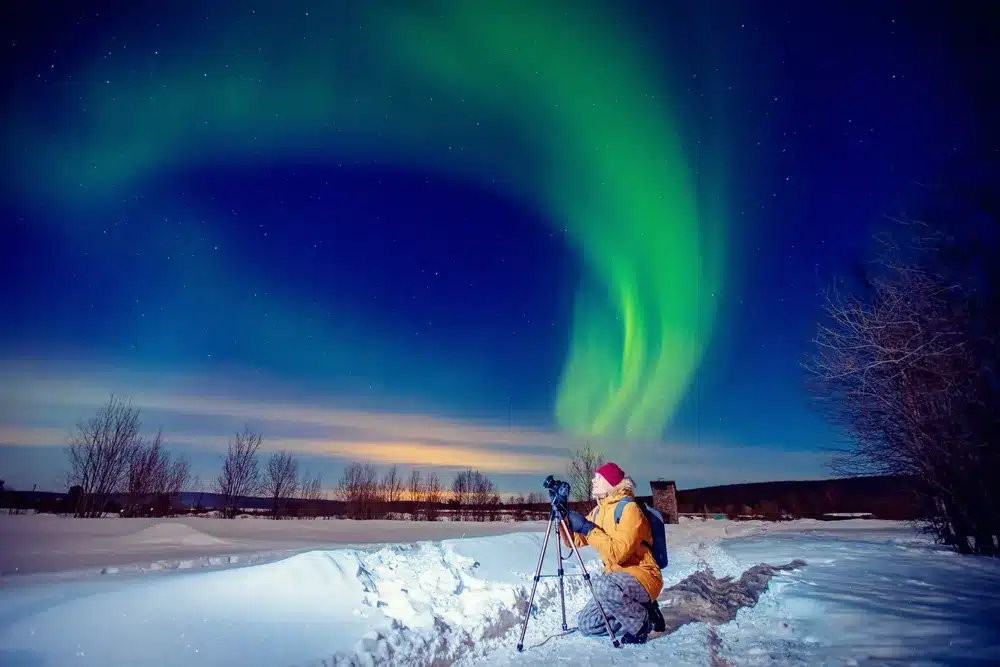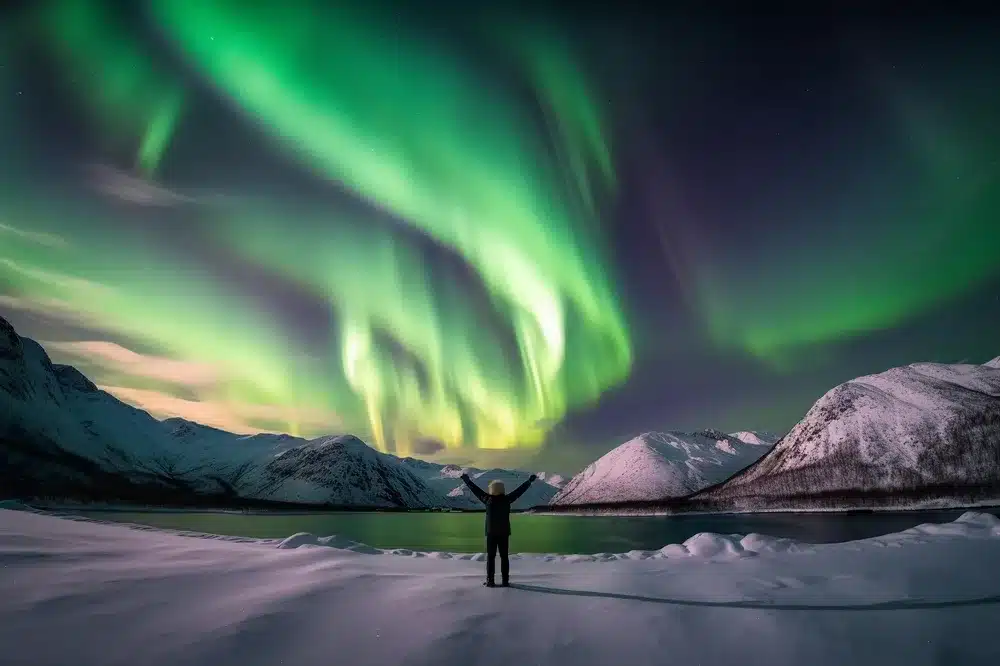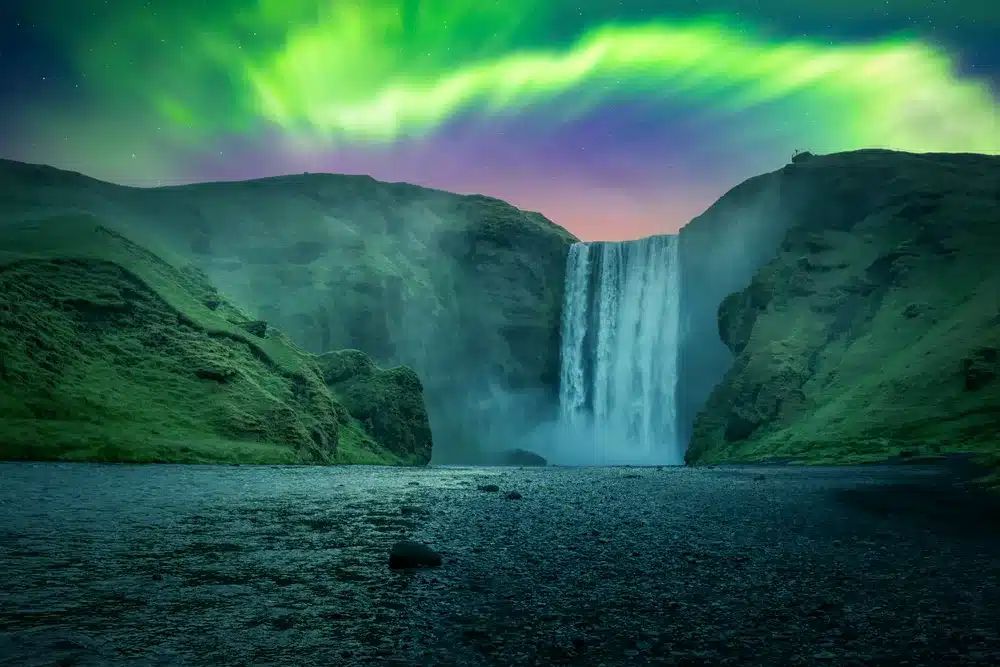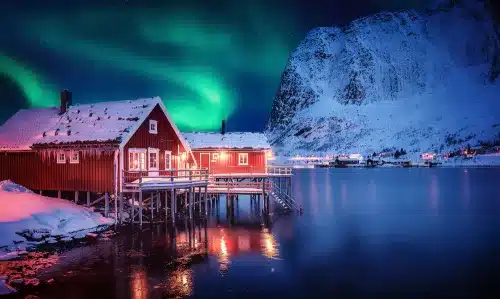
It is no secret that witnessing the Northern Lights is a bucket-list experience for many. But capturing the ethereal beauty of this natural wonder through photography requires skill and preparation. To help you on your quest to chase the aurora borealis, here are 9 essential photography tips for chasing the Northern Lights. Whether sailing along Norway’s coast on a ship or venturing into the Arctic wilderness, these expert insights will enhance your photography game.
Key Takeaways:
- Composition: Ensure the Northern Lights are framed with a captivating foreground like Norway’s mountains and fjords.
- Darkness: Escape light pollution for optimal viewing and avoid using flash or bright lights that can disrupt others.
- StabiliStabilization tripod to minimise and keep the aurora in focus during ship movements.
- Camera Settings: Familiarise yourself with the settings beforehand, adjust focus using stars, and experiment with ISO, shutter speed, aperture, and white balance.
- Preparation: Be ready at a moment’s notice with warm clothing, charged batteries, spare memory cards, hand warmers, and a red torch for comfort and convenience.
In this article we will give you the following 9 photography tips for chasing the Northern Lights:
How To Plan The Perfect Northern Lights Winter Getaway
1. Composition Is Key When Photographing the Northern Lights

Finding the Right Foreground
When photographing the Northern Lights, finding the right foreground is crucial. You must include something else in your composition to make the image visually attractive. With its dramatic mountains and fjords, Norway has the perfect natural foreground to complement the aurora in the sky. A wide-angle lens can help frame the celestial spectacle and the stunning landscape below.
The Rool Of Thirds
Mastering the rule of thirds is crucial for a suitable composition. Positioning critical elements in your photo along the lines or at the intersections of the gridlines can create a more visually appealing and balanced image. This technique is especially effective when capturing the Northern Lights, as it helps draw the viewer’s eye to the focal points of the scene, enhancing the overall impact of your photograph.
2. The Dark Is the Best.
Seeking Out Minimal Light Pollution
When photographing the Northern Lights, it is crucial to seek locations with minimal light pollution. You should get away from big crowds and light sources to truly capture the beauty of the auroras. This means finding a spot where streetlights and other artificial lights won’t compete with the spectacle in the night sky.
Understanding Exposure For Night Photography
Understanding exposure is critical to truly capturing the Northern Lights’ glory. Remember that when photographing auroras, your settings play a crucial role. Adjusting your shutter speed, ISO, aperture, and white balance can significantly affect your photos’ quality. Take some time to familiarise yourself with your camera’s settings before heading out to chase the lights so you can make the most of the experience without fumbling in the dark.
3. Stabilisation

Choosing the Right Tripod
Choose the right tripod for capturing the Northern Lights to keep your shots steady and sharp. Look for a compact, lightweight tripod that can minimise vibrations. A stabilised camera is imperative to prevent any blurriness in your aurora shots.
Using Remote Shutter Releases
A remote shutter release is an imperative accessory when photographing the Northern Lights. This handy tool lets you trigger your camera without touching it, minimises shaking, and ensures crisp images. Remote shutter releases are instrumental in cold weather conditions, where pressing the camera button can be challenging with gloves on.
4. Know the Settings on Your Camera
Mastering Manual Mode
Know the ins and outs of your camera settings before commencing your Northern Lights photography adventure. Understanding how to operate your camera in manual mode will give you complete control over your shots and precisely capture the beauty of the aurora borealis. Take the time to familiarise yourself with your camera’s settings so you can make adjustments quickly and efficiently when the Lights dance overhead.
ISO, Shutter Speed, And Aperture Balance
Finding the perfect balance between ISO, shutter speed, and aperture is crucial for optimal results when photographing the Northern Lights. Adjust your focus using a star as a marker and experiment with different settings to capture the aurora’s brilliance. Aim for a shutter speed of 5-25 seconds, depending on the activity level of the Lights, and keep your aperture at least f4 to let in enough Light. Remember, a highlight captures more light but can result in fewer images, so find the right balance for stunning photos.
5. Preparation Is the Key to Successfully Photographing the Northern Lights

Researching the Best Times And Locations For Photographing the Northern Lights
Learning the best times and locations is crucial to capture the mesmerising light. Knowing when and where the aurora will most likely appear can significantly increase your chances of getting that perfect shot. So, plan and scout for the best spots to frame the celestial spectacle with the stunning fjords and mountains below.
Checking Weather And Aurora Forecasts
Checking weather and aurora forecasts is imperative for a successful shoot when photographing the Northern Lights. Being away from big crowds and light sources is ideal, as it allows you to immerse yourself fully in the natural wonder of the aurora. Remember to use a red torch to navigate the dark without affecting your night vision. Understanding the factors influencing aurora activity, such as solar wind speed and geomagnetic storms, can help you anticipate when the lights will be most active and plan your shoots accordingly.
Use Your Smart Phone
Many of today’s smartphones can be used to photograph the Northern Lights, so you may already have what you need in your pocket. If you don’t have a ‘proper’ camera, or your camera runs out of batteries, or the Northern Lights take you completely by surprise one night, it’s good to know you can fall back on your smartphone. Just make sure you use a tripod or clamp.
Using High-ISO Capabilities
Using high-ISO capabilities on your camera can help capture more light in low-light situations, like when photographing the Northern Lights. Experiment with ISO settings to balance capturing enough light and maintaining light quality. Remember that higher ISO settings may introduce more noise to your images, so finding the right balance is critical.
6. Post-Processing Tips For Enhancing Images
- Use editing software like Adobe Lightroom to adjust your Northern Lights photos’ exposure, contrast, and colours.
- Consider increasing the clarity and sharpness to reveal the aurora’s details.
- Try playing with the temperature and tint settings to enhance the colours of the aurora.
Enhancing your Northern Lights images in post-processing can help bring out the beauty of the aurora you witnessed in person. Take the time to fine-tune your photos to create stunning visuals that truly capture the magic of the Northern Lights.
7. The Importance of Patience in Night Photography

Patience is critical to capturing the mesmerising Northern Lights. Unlike daytime photography, where natural light is abundant, night photography requires waiting for the perfect moment to capture the aurora’s dance across the sky. Embrace the quiet moments in between shots, as they can lead to the most breathtaking images.
8. Embracing the Unpredictable Nature of Auroras
To truly immerse yourself in the art of capturing the Northern Lights, embrace the unpredictable nature of auroras. The lights can appear anywhere, anytime along the Norwegian coast, so be prepared for sudden changes in intensity and activity. Trust in your skills and equipment while being open to the natural world’s magic.
A flask with a warm drink, hand warmers, and a red torch can also make the experience more comfortable when photographing the Northern Lights. Keep all your outdoor gear together and ready to throw on at a moment’s notice. Remember that batteries drain faster in cold weather, so always have a charged camera and spare batteries. Your memory card should have a large storage capacity to ensure you capture every moment of the aurora’s breathtaking display.
9. Tips From the Pros

For those beginning a Northern Lights photography journey, learning from experienced photographers can make a significant difference in capturing the beauty of the aurora. One valuable piece of advice from seasoned pros is always to consider the composition of your photo. Adding a dramatic foreground, such as Norway’s stunning mountains, can elevate the visual impact of your Northern Lights shots. To dive deeper into expert tips and tricks for chasing the Northern Lights, check out this insightful article on Chasing the Northern Lights in Norway.
Advice From Experienced Northern Lights Photographers
Northern Lights photography experts emphasise the importance of composition in capturing the aurora’s beauty. You can create visually compelling images, including elements like Norway’s picturesque landscapes. Remember to find darker areas away from light pollution for optimal viewing and photographing conditions.
We have now given you 9 photography tips for chasing the Northern Lights. Mastering successfully photographing the Northern Lights requires more than just pointing and shooting. By following these essential tips from photography experts, beginners can enhance their skills and create stunning images of this natural phenomenon. From understanding composition to mastering camera settings and being prepared for the unexpected, these tips provide a comprehensive guide for photographers of all levels.
Amazing Facts About the Northern Lights And Where To See Them In Norway
FAQ
-
How can beginners capture stunning photos of the Northern Lights?
Beginners can capture stunning photos of the Northern Lights by following these essential photography tips tailored for chasing the aurora borealis.
-
What is the importance of composition in Northern Lights photography?
Composition is crucial when photographing the Northern Lights. It enhances the visual appeal of the photo by incorporating elements like Norway’s dramatic landscapes to create a captivating image.
-
How important is finding a dark location for photographing the Northern Lights?
Finding a dark location away from crowds and artificial light sources is essential to ensuring the best visibility of the Northern Lights and preventing light pollution from impacting the quality of the photos.
-
Why is stabilising media important when capturing the Northern Lights?
Stabilising media is crucial when photographing the Northern Lights. It prevents motion blur caused by the camera’s movement, ensuring sharp and focused images of the aurora borealis.
-
What camera settings are recommended for capturing the Northern Lights?
Recommended camera settings for capturing the Northern Lights include adjusting the focus using a star in the sky, experimenting with shutter speeds based on aurora activity, setting the aperture to let in enough Light, selecting the white balance, and being prepared with spare batteries and memory cards for extended shooting sessions.
Other Articles About This Subject:
- 10 Tips for Shooting Stunning Photos of the Aurora Shutterstock
- How to photograph the Northern lights Visit Norway







